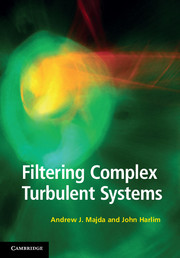Book contents
- Frontmatter
- Contents
- Preface
- 1 Introduction and overview: Mathematical strategies for filtering turbulent systems
- Part I Fundamentals
- Part II Mathematical guidelines for filtering turbulent signals
- 5 Stochastic models for turbulence
- 6 Filtering turbulent signals: Plentiful observations
- 7 Filtering turbulent signals: Regularly spaced sparse observations
- 8 Filtering linear stochastic PDE models with instability and model error
- Part III Filtering turbulent nonlinear dynamical systems
- References
- Index
8 - Filtering linear stochastic PDE models with instability and model error
from Part II - Mathematical guidelines for filtering turbulent signals
Published online by Cambridge University Press: 05 March 2012
- Frontmatter
- Contents
- Preface
- 1 Introduction and overview: Mathematical strategies for filtering turbulent systems
- Part I Fundamentals
- Part II Mathematical guidelines for filtering turbulent signals
- 5 Stochastic models for turbulence
- 6 Filtering turbulent signals: Plentiful observations
- 7 Filtering turbulent signals: Regularly spaced sparse observations
- 8 Filtering linear stochastic PDE models with instability and model error
- Part III Filtering turbulent nonlinear dynamical systems
- References
- Index
Summary
A major difficulty in accurate filtering of noisy turbulent signals with many degrees of freedom is model error; the true signal from nature is processed for filtering and prediction through an imperfect model in which numerical approximations are imposed and important physical processes are parametrized due to inadequate resolution or incomplete physical understanding. In Chapters 2 and 6, we discussed the filtering performance on a canonical linear stochastic PDE model for turbulence in the presence of model error through discrete numerical solvers. Subsequently, in Chapter 7 we assessed the filtering performance with model error that arises from reduced filtering strategies that are used when the observations are sparse.
In this chapter, we discuss filtering with model error which arises from unstable turbulent processes that are often observed in nature such as the intermittent burst of baroclinic instability in the mid-latitude atmosphere and ocean turbulent dynamics and which might be hidden from the forecast model. In the study below, we will simulate an intermittent burst of instability with two-state Markov damping coefficients; we allow the damping coefficients of some Fourier modes in the turbulent model (SPDE in Chapter 5) to be negative (or unstable) on some random occasions with a positive long-time average damping (i.e. an overall stable dynamics). We will prescribe the switching times between the two (stable and unstable) states to be randomly drawn from exponential distributions.
- Type
- Chapter
- Information
- Filtering Complex Turbulent Systems , pp. 116 - 130Publisher: Cambridge University PressPrint publication year: 2012



